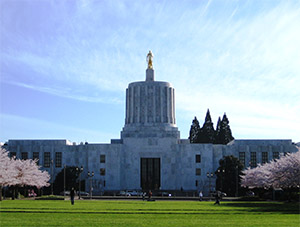
A year ago, a band of militants descended on a National Wildlife Refuge in Oregon, and with them came a cadre of national reporters. National reports were often simplistic, neglecting important nuances to the story and left readers and viewers with poor understanding of facts on the ground.
While local coverage by several Oregon outlets was more thorough and provided analysis, the one-year anniversary of the Malheur occupation provides an opportunity to reflect on key elements of the saga that flew under the radar.
The Malheur Occupation was a new phenomenon in Oregon
The Bundy seizure of the Malheur Refuge was not the first militia takeover of public property in Oregon, nor the first armed stand-off. During the drought of 2001, militia groups from as far away as Jarbidge, NV and Kalispell, MT descended on Klamath Falls to participate in a takeover of the US Bureau of Reclamation’s irrigation headgates on Upper Klamath Lake, to oppose federal efforts to protect salmon and other fish. Tensions escalated during that months-long stand-off to the point where USFWS employees were told not to wear their uniforms in town, and then-Sheriff Tim Evinger asked federal law enforcement officials to leave to avoid provoking militia members. That stand-off was resolved on Sept. 11th, when the attack on NY City and the Pentagon prompted militia groups to finally leave.
In 2015, shortly after the Bunkerville standoff where Cliven Bundy drew national attention for over a decade of flouting the law, armed militants gathered again in southern Oregon to protest a BLM administrative action on a mine. The self-styled “Patriot” Oathkeepers issued numerous overtly false “call to arms” press releases, claiming that freedom itself hinged on the armed defense of a pair of miners who had to fill out some mining claim paperwork. It was enough to draw a number of militants from across the West who closed roads and public access, setting up an armed perimeter. The BLM offices in both Grants Pass and Klamath Falls closed for a day because employees there were receiving death threats.
The occupation was a protest about the unjust imprisonment of innocent local ranchers
While the Bundy brothers claimed to have arrived in Oregon to participate in a protest over the imprisonment of the Hammonds, their real aim was transparently the end of national public lands and aspirations of a West-wide uprising. However, Dwight Hammond and his son Steven, the ranchers imprisoned for two counts of arson on federal lands, were hardly innocent. While they did not support the occupation, both men had a long and substantial record of illegal behavior that included child abuse and threats of violence directed at environmental activists and local public lands managers. According to court documents, the 2001 arson was started to cover up deer poaching.
Many have voiced legitimate concerns with mandatory minimum sentencing and the particular law, the Antiterrorism and Effective Death Penalty Act of 1996, that the Hammonds were sentenced under. Unfortunately, most Hammond supporters selectively targeted the application of that particular law to the pair of ranchers, rather than the broader issues with the law itself.
The Bundy brothers were independent radicals
 The Bundy’s were inspired by decades of anti-government and anti-public lands political organizing in the rural west dating back to the 1960’s. In recent years, this movement has drawn support from the Koch brothers and other major oil and gas industry funders. The Koch’s have backed the American Lands Council to lobby state legislatures, county commissions, and local governments all over the West to support public lands privatization, and they have funded the American Legislative Exchange Council (ALEC) to draft model bills for state legislatures demanding the transfer of public lands.
The Bundy’s were inspired by decades of anti-government and anti-public lands political organizing in the rural west dating back to the 1960’s. In recent years, this movement has drawn support from the Koch brothers and other major oil and gas industry funders. The Koch’s have backed the American Lands Council to lobby state legislatures, county commissions, and local governments all over the West to support public lands privatization, and they have funded the American Legislative Exchange Council (ALEC) to draft model bills for state legislatures demanding the transfer of public lands.
Land seizure advocates have made the most significant progress in Utah, where the 2012 Transfer of Public Lands Act required the federal government to transfer the ownership of over 30 million acres of federally protected land to the state by the end of 2014, a mandate which federal agencies did not comply with. Foreseeing federal non-compliance, the bill also set aside $4.5 million to cover the state’s legal fees, although the constitutionality of such a bill will likely not withstand the courts.
Oregon saw action on one of these ALEC-inspired bills in 2015.
The Bundy movement is made up of outsiders with no ties to Oregon
In fact, home-grown militia groups here in Oregon supported the Bundy’s, and some supported their goals for years before the Malheur seizure. Many of the participants at the refuge stand-off participated in the Sugar Pine stand-off in 2015. Sheriff Glenn Palmer has deep ties to militia groups in Grant County, and offered public support the Bundy’s. Crook County also suffered the emergence of a home-grown anti-government militia group in recent years, which has proposed a natural resources management plan that would give county officials control of Forest Service lands.
Rural Organizing Project’s Guide to Oregon’s militia movement.
The spotted owl and environmentalists killed Harney County’s economy
 Many national reports cited the listing of the Northern Spotted Owl under the Endangered Species Act for Harney County’s economic woes. While this may be a belief held by some individuals, it is patently false. The city of Burns and the Malheur Wildlife Refuge are over 100 miles away from the nearest old-growth habitat protected by the Northwest Forest Plan - the agreement put in place to halt the reckless clearcutting of western Oregon’s public forests and protect old growth habitat.
Many national reports cited the listing of the Northern Spotted Owl under the Endangered Species Act for Harney County’s economic woes. While this may be a belief held by some individuals, it is patently false. The city of Burns and the Malheur Wildlife Refuge are over 100 miles away from the nearest old-growth habitat protected by the Northwest Forest Plan - the agreement put in place to halt the reckless clearcutting of western Oregon’s public forests and protect old growth habitat.
While some environmental standards were enacted to protect old growth trees in eastern Oregon as well, a number of other factors had a greater economic impact on the region and logging industry as a whole: increasing automation, the 2007 housing bubble, globalization, distance from markets and competition with mills in western Oregon, the fact that slower-growing dry-side forests had largely been liquidated by the clearcutting sprees on the 70s and 80s, and changing management to address forest fires. However, conservation groups like Oregon Wild have worked to help keep eastern Oregon mills open to process small diameter wood harvested from forest health restoration projects.
It’s over
The consequences of the Malheur occupation have been widespread, with the continued intimidation of some federal employees (and some rumors of direct violence) in east Oregon communities like Burns and John Day. Both on the Malheur Wildlife Refuge and Malheur National Forest, many long time employees have left, and others have been told by long-time friends that they can’t be seen together in public.
Malheur occupiers also recently announced an event in John Day, OR called “The Meeting That Never Happened.” Many are concerned this event will lead to an occupation of a Grant County Forest Service facility and that counter-protesters may face reprisals from the pro-takeover Grant County Sheriff Glenn Palmer.
Ryan Bundy has issued an ominous warning from from jail on the announcement that President Obama had declared new national monuments in Nevada and Utah: “The government should be scared.”

